Klyuchevskaya Sopka
Klyuchevskaya Sopka (Russian: Ключевская сопка; also known as Klyuchevskoi, Russian: Ключевской) is a stratovolcano, the highest mountain on the Kamchatka Peninsula of Russia and the highest active volcano of Eurasia. It is the highest mountain in Siberia (Asian Russia). Its steep, symmetrical cone towers about 100 kilometres (60 mi) from the Bering Sea. The volcano is part of the natural Volcanoes of Kamchatka UNESCO World Heritage Site.
| Klyuchevskaya Sopka | |
|---|---|
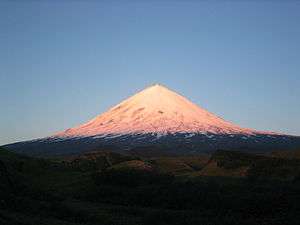 Klyuchevskaya Sopka in January 2007 | |
| Highest point | |
| Elevation | 4,750 m (15,580 ft) |
| Prominence | 4,649 m (15,253 ft) Ranked 13th |
| Isolation | 2,748 km (1,708 mi) |
| Listing | Ultra |
| Coordinates | 56°03′22″N 160°38′39″E |
| Geography | |
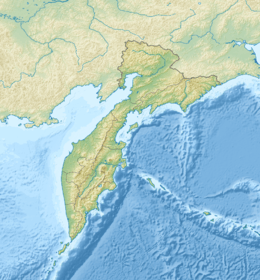 Klyuchevskaya Sopka Location in Kamchatka Krai, Russia | |
| Location | Kamchatka, Russia |
| Parent range | Eastern Range |
| Geology | |
| Mountain type | Stratovolcano (active) |
| Last eruption | 2020 |
| Climbing | |
| First ascent | 1788 by Daniel Gauss and 2 others |
| Easiest route | basic rock/snow climb |
Klyuchevskaya appeared 6,000 years ago.[1] Its first recorded eruption occurred in 1697,[2] and it has been almost continuously active ever since, as have many of its neighboring volcanoes. It was first climbed in 1788 by Daniel Gauss and two other members of the Billings Expedition.[3] No other ascents were recorded until 1931, when several climbers were killed by flying lava on the descent. As similar dangers still exist today, few ascents are made.
Klyuchevskaya Sopka is considered sacred by some indigenous peoples, being viewed by them as the location at which the world was created. Other volcanoes in the region are seen with similar spiritual significance, but Klyuchevskaya Sopka is the most sacred of these.
Eruptions
2007 eruption
Beginning in early January 2007, the Klyuchevskaya volcano began another eruption cycle. Students from the University of Alaska Fairbanks and scientists of the Alaska Volcano Observatory traveled to Kamchatka in the spring to monitor the eruption. On 28 June 2007, the volcano began to experience the largest explosions so far recorded in this eruption cycle. An ash plume from the eruption reached a height of 10 km (33,000 ft) before drifting eastward, disrupting air traffic from the United States to Asia and causing ashfalls on Alaska's Unimak Island.
2010 eruption
As early as 27 February 2010, gas plumes had erupted from Klyuchevskaya Sopka (reaching elevations of 7,000 m (23,000 ft)) and during the first week of March 2010, both explosive ash eruptions and effusive lava eruptions occurred until, by 9 March, the ash cloud was reported to have reached an elevation of 6,000 m (20,000 ft). Also, significant thermal anomalies have been reported and gas-steam plumes extended roughly 50 km (31 mi) to the north-east from the volcano on 3 March.
2012 eruptions
On 15 October 2012 the volcano had a weak eruption that stopped the following day. Also a weak thermal eruption occurred on 29 November 2012, then stopped again, as all of its neighboring volcanoes Bezymianny, Karymsky, Kizimen, Shiveluch, and Tolbachik erupted more actively and continuously, taking a major magma supply load off of Klyuchevskaya Sopka.
2013 eruptions
On 25 January 2013 the volcano had a weak or lazy-type strombolian eruption that stopped the following day. During January 2013, all volcanoes in the eastern part of Kamchatka —Bezymianny, Karymsky, Kizimen, Klyuchevskaya Sopka (aka Kliuchevskoi), Shiveluch, and Tolbachik erupted except Kamen (volcano).
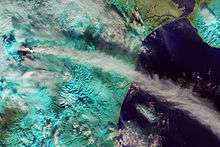
On August 15, 2013, the volcano had another weak Strombolian eruption with some slight lava flow that put on an excellent fireworks display before stopping on August 21, 2013, when Gorely Volcano woke up and started erupting again in relief of Klyuchevskaya Sopka.
On October 12, Klyuchevskaya had another three days of on-and-off eruptions with anomalies and a short ash plume, possibly indicating Strombolian and weak Vulcanian activity. An explosion from a new cinder cone low on Kliuchevskoi's southwest flank occurred on October 12. An ash plume rose to altitudes of 6–7 km (20,000–23,000 ft), and drifted eastward. The eruptions weakened and paused by October 16, 2013.[4]
On November 19, a strong explosion occurred, and observers reported that ash plumes rose to altitudes of 10–12 km (33,000–39,000 ft) and drifted southeast. The Aviation Color Code was raised to Red. Later that day the altitudes of the ash plumes were lower and the eruptions weakened and stopped again.
On December 7, activity at Kliuchevskoi significantly increased, having continued during November 29 – December 7, prompting KVERT to raise the Alert Level to Red. Ash plumes rose to altitudes of 5.5–6 km (18,000–20,000 ft) above sea level and drifted more than 212 km northeast and over 1,000 km east. According to a news article, a warning to aircraft was issued for the area around the volcanoes. Video showed gas-and-steam activity, and satellite images detected a daily weak thermal anomaly. On December 9, the Alert Level was lowered to Green when the eruptions abruptly stopped.
2015 eruptions
On January 2, 2015, after a one-year period of inactivity, the volcano had a strombolian eruption which stopped on January 16, 2015. Minor eruptions resumed on March 10, 2015 and stopped on March 24, 2015. On August 27, 2015 the volcano had another strombolian eruption which ended 16 hours later. On October 25, 2019 the volcano had another weak strombolian eruption which ended some 30 hours later. This type of minor eruptions continued through 2016 and into 2019.
2019-2020 eruptions
Kluchevskaya Sopka saw renewed eruption activity beginning in 2019 and continuing into 2020.
Images
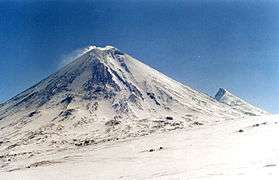 Klyuchevskaya Sopka in July 2006
Klyuchevskaya Sopka in July 2006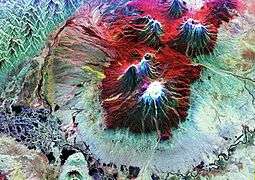
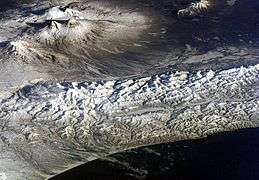 Satellite image of Klyuchevskaya Sopka in April 2010 by NASA.
Satellite image of Klyuchevskaya Sopka in April 2010 by NASA.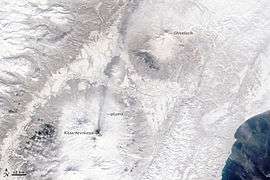 Satellite image and map of Klyuchevskaya Sopka in 2002 by NASA.
Satellite image and map of Klyuchevskaya Sopka in 2002 by NASA.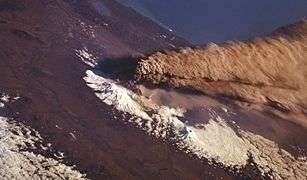 The eruption of October 1994.
The eruption of October 1994.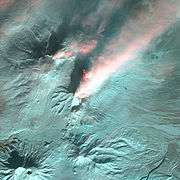 The eruption of February 2005.
The eruption of February 2005.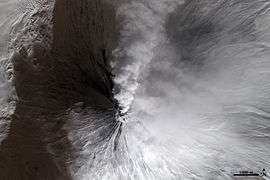 The eruption of February 2010 taken by NASA ASTER.
The eruption of February 2010 taken by NASA ASTER.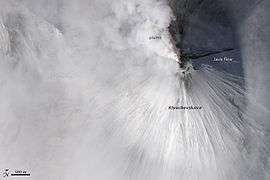 The eruption of March 2010.
The eruption of March 2010.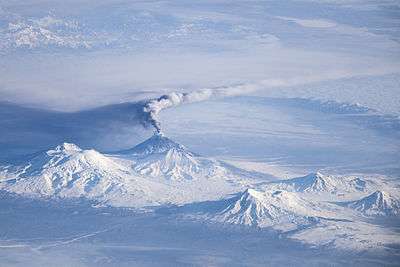 The eruption of November 16, 2013. Ushkovsky, Tolbachik, Zimina, Udina, and Bezymianny are also visible.
The eruption of November 16, 2013. Ushkovsky, Tolbachik, Zimina, Udina, and Bezymianny are also visible.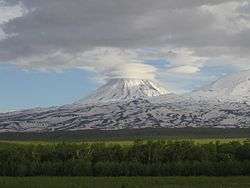 Kluchevskaya Sopka
Kluchevskaya Sopka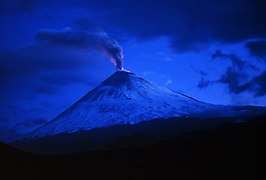 Eruption of summer 1993
Eruption of summer 1993
See also
| Wikimedia Commons has media related to Klyuchevskaya Sopka. |
References
- Entre volcans et saumons : voyage d’exception au Kamtchatka. Atlantico. Retrieved on 2018-10-25.
- Global Volcanism Program: Kliuchevskoi, eruptive history. Volcano.si.edu. Retrieved on 2014-05-15.
- Dobkin, Josef (1989), "The Living Giants of Kamchatka", The American Alpine Journal 1989, New York: The American Alpine Club, p. 104, ISBN 0-930410-39-4
- "Global Volcanism Program | Report on Klyuchevskoy (Russia) — 16–22 October 2013". volcano.si.edu. Retrieved 2018-04-26.
External links
- Klyuchevskaya Volcano at the Encyclopædia Britannica
- Klyuchevskaya Sopka (Climbing). on author's site sgan2009.ru "Russia begins here" (in Russian)
- "Kliuchevskoi". Global Volcanism Program. Smithsonian Institution. Retrieved 2008-12-18.
- Klyuchevskoy Volcano live webcam
- "Klyuchevskaya Sopka". Peakware.com. Archived from the original on 2016-03-04. – photos
- Science Daily article on the 2007 eruption's disruption of air traffic